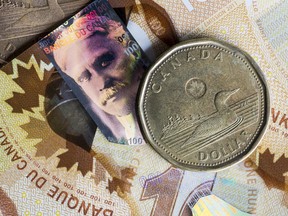Jack Mintz: A Sinking Dollar Is Trudeau’s Latest Legacy

Here is the rewritten text without the ads:
Jack Mintz: A sinking dollar is Trudeau’s latest legacy
The Canadian dollar has a long history of playing a significant role in federal elections. It wouldn’t be surprising if it does again in 2025’s election.
One famous instance was the devaluation of the "Diefenbuck." During this time, the Canadian economy was weakening, and the Diefenbaker government was fighting over monetary policy with Bank of Canada governor James Coyne. As a result, our dollar sank from parity to 92.5 US cents (where it was fixed in 1962 in an agreement with the IMF), and so did the fortunes of the Diefenbaker government, which eventually lost office in 1963.
In 1974, the loonie reached its peak at $1.04 but slid to 69.1 cents in 1986 due to growing deficits, lower commodity prices, and the threat of Quebec separation. It hit its all-time low of 61.8 US cents in January 2002, the result of weak commodity prices and global uncertainty following the September 2001 attack on the U.S.
After a resource boom and continued fiscal responsibility brought our dollar back up to parity during the Harper years, it fell to below 80 US cents when commodity prices collapsed after October 2014. Since 2018, it has fluctuated around 75 cents but has trended down once again since early last year. After Chrystia Freeland resigned as finance minister, it dipped below 70 cents, as political turmoil loomed.
Factors contributing to the Canadian dollar’s weakness
Commodity prices play a significant role in weakening our dollar: resources account for over half of our export earnings. Political risk also plays a big part. If real interest rates stay higher in the U.S., investors will prefer American to Canadian bonds. Increased private and public indebtedness to the rest of the world also puts pressure on our dollar as investors become more concerned about our ability to service that debt.
Expect the Canadian dollar to weaken further in 2025
Oil prices are likely to soften due to falling Chinese demand and an oil supply glut. The U.S. Federal Reserve is not expected to cut interest rates as much as the Bank of Canada has felt necessary, given our weaker economy and lower inflation forecasts. And our indebtedness continues to grow — with the IMF expecting Canada’s balance of payments to weaken further even well beyond this year.
The Trump tariffs could also lead to a weakening Canadian dollar. Should they be applied on Trump’s first day in office, expect the loonie to weaken even further this month. That will soften the tariffs’ impact on Canadian exporters but will hurt Canadian importers. U.S. tariffs will also encourage Canadian companies to shift production and capital to the U.S.
A negative legacy for Trudeau
If the loonie falls further this year, that will be another negative in Justin Trudeau’s legacy. On top of all their other economic challenges, Canadians don’t want a declining currency too.